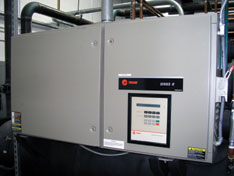The Bulldogs play their home games at the Robert Ewigleben Ice Arena. In the spring of 2003, the facility suffered major breakdowns on two of its three reciprocating chillers used for making ice. A popular spring tournament was scheduled for the first week of April, and unless repairs could be made or another solution found, the tournament would have to be cancelled.
An inspection of the failed chillers indicated that repairs would be expensive and time consuming. Ironically, new chillers had been ordered prior to the breakdown, but they weren't ready to be installed.

Quick Solution Needed
The ice arena features an ice surface measuring 85 feet by 200 feet. With a seating capacity of 2,457, the arena also features a half-size rink for recreational use, three dressing rooms with direct access to the ice surface, a multipurpose wing, and the Bulldog lounge, which is used for pre- and post-game activities.The three reciprocating chillers were part of the original installation at the 26-year-old facility. Just weeks before two of the three chillers broke down, the university had made plans to replace the three chillers with two Trane water-cooled screw chillers. With the new equipment on order, a solution was needed to keep the tournament on track.
Fortunately, the university found a solution through Trane's ChillerSource temporary cooling group, which provided a temporary air-cooled chiller equipped for glycol operation. Technicians isolated the failed chillers and installed piping connections for chilled water lines from the temporary machine, which was delivered within 24 hours. The temporary chiller was set in a small parking area near the arena mechanical plant.
Chuck Fischer, project development manager, Western Michigan Trane Commercial Sales Office, Grand Rapids, Mich., noted that while the old system did not have any taps for a bypass, "The new system incorporates some cut-ins for emergency use in the future."

A Permanent Solution Arrives
Following the completion of the tournament, work began immediately on the installation of the new permanent ice-making equipment. Roger Bula, environmental engineer, Ferris State University, stated that choosing water-cooled screw chillers made sense for the ice rink. "We were looking for the best and most economical total cost package," he said. "Our previous chillers were inefficient and required a three-week downtime every year for a complete rebuild. We needed a better system."The new system consists of two new Trane Series R Model RTHC water-cooled screw chillers, which utilize R-134a and have a nominal rating of 200 tons each. In this ice-making application with glycol, they have a rating of 104 tons each. The system performs at a wide range of loads and can deliver glycol at the low temperatures needed for good ice.
"It's actually a decoupled chilled water system," stated Fischer. "The ice is basically a high-flow low delta system, because the large rink needs about 950 gpm. The design specifications are approximately 18.5 degrees F supply with a 20.5 degrees F return, so it's only a 2 degrees F delta T. That's one of the reasons we decoupled it, because it works better that way."

The existing chiller plant was essentially gutted before the new chillers were installed. A new pad was poured, the room was repainted, then all the new equipment was installed. The equipment was installed on a tight schedule between the end of the hockey season in mid-April and the need for ice June 4 for summer youth and college programs. "The schedule was a challenge, but we made it," said Fischer. "Thankfully, we didn't run into any problems."
A Trane Tracer Summit control system was also installed for the ice-making plant. The controls typically set the chiller plant glycol output temperature at 15 degrees F, which is low enough to hold ice at the temperature preferred for intercollegiate hockey. If the skating application should change, perhaps for a figure skating show, the ice temperature can be adjusted with the control system.

The university has recently decided to install several variable-frequency drives on the rink pumps, which will keep the water moving all the time. "Some rinks cycle the water, so when the rink gets to a certain temperature, the pumps shut off," said Fischer. "Ferris wants to be able to back the flow down but still keep the water moving. That will save them some energy and ensure a supply of good ice, which the arena is known for."
The new facility is up and running, and the physical plant personnel are happy with the results. "The system offers flexibility for future requirements," said Bula. "For example, if we expand or replace the arena in the future, we can continue to get use out of these machines. We can also add chillers if more capacity is needed."
Publication date: 07/12/2004




